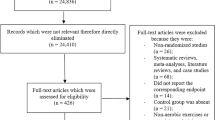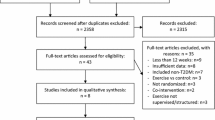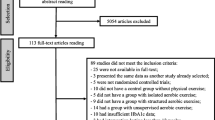Abstract
Background
Previous meta-analyses indicated that aerobic exercise can improve glycemic control. However, the optimum dose of exercise is still being discussed.
Objective
The aim of this study was to examine the dose-dependent effect of supervised aerobic training (SAT) on glycated hemoglobin (HbA1c).
Methods
We searched PubMed, Scopus, and Web of Science to May 2021 for randomized trials with an intervention period of 12 weeks or longer evaluating the effect of SAT on HbA1c in adults with type 2 diabetes mellitus. Secondary outcomes included quality of life, change in hypoglycemic medications, and adverse events. A random-effects dose–response meta-analysis was conducted.
Results
The analysis of 26 trials with 1253 participants indicated that each 30-min/week SAT reduced HbA1c by − 0.22 percentage point (95% CI − 0.29 to − 0.15; GRADE = strong). Levels of HbA1c decreased proportionally with the increase in the duration of moderate to vigorous-intensity SAT to 100 min/week (mean difference100 min/week: − 0.96 percentage point, 95% CI − 1.25 to − 0.67), with flattening of the curve at higher duration. Aerobic exercise decreased antidiabetic medications by 13 per 100 patients (risk difference 0.13, 95% CI 0.02–0.23; 7 trials, n = 375; GRADE = moderate), and increased hypoglycemic reactions by 10 per 100 patients (risk difference: 0.10, 95% CI 0.03–0.17; 4 trials, n = 263; GRADE = low) and adverse events by 4 per 100 patients (risk difference: 0.04, 95% CI − 0.02 to 0.11; 2 trials, n = 236; GRADE = low). Limited evidence is available for quality of life.
Conclusions
Every 30 min/week of moderate to vigorous aerobic exercise can exert a significant effect on HbA1c, with the highest effect observed from 100 min/week and above. However, exercise durations above 100 min/week seem ineffective for further reductions.
Protocol Registration
PROSPERO (CRD42021257251).





Similar content being viewed by others
References
Lin X, Xu Y, Pan X, Xu J, Ding Y, Sun X, et al. Global, regional, and national burden and trend of diabetes in 195 countries and territories: an analysis from 1990 to 2025. Sci Rep. 2020;10(1):1–11.
Shaw JE, Sicree RA, Zimmet PZ. Global estimates of the prevalence of diabetes for 2010 and 2030. Diabetes Res Clin Pract. 2010;87(1):4–14.
Riddle MC, Herman WH. The cost of diabetes care—an elephant in the room. Diabetes Care. 2018;41(5):929–32.
Harding JL, Pavkov ME, Magliano DJ, Shaw JE, Gregg EW. Global trends in diabetes complications: a review of current evidence. Diabetologia. 2019;62(1):3–16.
Hirsch IB. Glycemic variability and diabetes complications: does it matter? Of course it does! Diabetes Care. 2015;38(8):1610–4.
Sullivan PW, Morrato EH, Ghushchyan V, Wyatt HR, Hill JO. Obesity, inactivity, and the prevalence of diabetes and diabetes-related cardiovascular comorbidities in the US, 2000–2002. Diabetes Care. 2005;28(7):1599–603.
Association AD. Executive summary: standards of medical care in diabetes—2012. Diabetes Care. 2012;35(Suppl 1):S4–10.
Association AD. 5. Facilitating behavior change and well-being to improve health outcomes: Standards of Medical Care in Diabetes—2020. Diabetes Care. 2020;43(Suppl 1):S48–65.
Nesti L, Pugliese NR, Sciuto P, Natali A. Type 2 diabetes and reduced exercise tolerance: A review of the literature through an integrated physiology approach. Cardiovasc Diabetol. 2020;19(1):1–17.
Umpierre D, Ribeiro PA, Kramer CK, Leitao CB, Zucatti AT, Azevedo MJ, et al. Physical activity advice only or structured exercise training and association with HbA1c levels in type 2 diabetes: a systematic review and meta-analysis. JAMA. 2011;305(17):1790–9.
Pan B, Ge L, Xun Y-Q, Chen Y-J, Gao C-Y, Han X, et al. Exercise training modalities in patients with type 2 diabetes mellitus: a systematic review and network meta-analysis. Int J Behav Nutr Phys Act. 2018;15(1):1–14.
Bretz F, Hsu J, Pinheiro J, Liu Y. Dose finding—a challenge in statistics. Biom J J Math Methods Biosci. 2008;50(4):480–504.
Crippa A, Orsini N. Dose-response meta-analysis of differences in means. BMC Med Res Methodol. 2016;16(1):1–10.
Higgins JP, Thomas J, Chandler J, Cumpston M, Li T, Page MJ, et al. Cochrane handbook for systematic reviews of interventions. New York: Wiley; 2019.
Schunemann H. GRADE handbook for grading quality of evidence and strength of recommendation. Version 3.2 (2008). http://www.cc-ims.net/gradepro.
Kilpatrick ES. Haemoglobin A1c in the diagnosis and monitoring of diabetes mellitus. J Clin Pathol. 2008;61(9):977–82.
Sullivan M, Sullivan L, Kral J. Quality of life assessment in obesity: physical, psychological, and social function. Gastroenterol Clin North Am. 1987;16(3):433–42.
Norton K, Norton L, Sadgrove D. Position statement on physical activity and exercise intensity terminology. J Sci Med Sport. 2010;13(5):496–502.
Higgins JP, Altman DG, Gøtzsche PC, Jüni P, Moher D, Oxman AD, et al. The Cochrane Collaboration’s tool for assessing risk of bias in randomised trials. BMJ. 2011;343.
Chandler J, Cumpston M, Li T, Page M, Welch V. Cochrane handbook for systematic reviews of interventions. Hoboken: Wiley; 2019.
Higgins JP, Deeks JJ. Selecting studies and collecting data. Cochrane handbook for systematic reviews of interventions: Cochrane book series; 2008. p. 151–85.
Furukawa TA, Barbui C, Cipriani A, Brambilla P, Watanabe N. Imputing missing standard deviations in meta-analyses can provide accurate results. J Clin Epidemiol. 2006;59(1):7–10.
DerSimonian R, Laird N. Meta-analysis in clinical trials. Control Clin Trials. 1986;7(3):177–88.
Schandelmaier S, Briel M, Varadhan R, Schmid CH, Devasenapathy N, Hayward RA, et al. Development of the Instrument to assess the Credibility of Effect Modification Analyses (ICEMAN) in randomized controlled trials and meta-analyses. CMAJ. 2020;192(32):E901–6.
Egger M, Smith GD, Schneider M, Minder C. Bias in meta-analysis detected by a simple, graphical test. BMJ. 1997;315(7109):629–34.
Begg CB, Mazumdar M. Operating characteristics of a rank correlation test for publication bias. Biometrics; 1994. p. 1088–101.
Higgins JP, Savović J, Page MJ, Elbers RG, Sterne JA. Assessing risk of bias in a randomized trial. Cochrane handbook for systematic reviews of interventions; 2019. p. 205–28.
Guyatt GH, Oxman AD, Vist GE, Kunz R, Falck-Ytter Y, Alonso-Coello P, et al. GRADE: an emerging consensus on rating quality of evidence and strength of recommendations. BMJ. 2008;336(7650):924–6.
Guyatt GH, Oxman AD, Kunz R, Brozek J, Alonso-Coello P, Rind D, et al. GRADE guidelines 6. Rating the quality of evidence—imprecision. J Clin Epidemiol. 2011;64(12):1283–93.
Guyatt G, Oxman AD, Kunz R, Brozek J, Alonso-Coello P, Rind D, et al. Corrigendum to GRADE guidelines 6. Rating the quality of evidence-imprecision. J Clin Epidemiol 2011; 64: 1283–1293. J Clin Epidemiol. 2021;137:265.
Goldenberg JZ, Day A, Brinkworth GD, Sato J, Yamada S, Jönsson T, et al. Efficacy and safety of low and very low carbohydrate diets for type 2 diabetes remission: systematic review and meta-analysis of published and unpublished randomized trial data. BMJ. 2021;372.
Alvarez C, Ramirez-Campillo R, Martinez-Salazar C, Mancilla R, Flores-Opazo M, Cano-Montoya J, et al. Low-volume high-intensity interval training as a therapy for type 2 diabetes. Int J Sports Med. 2016;37(09):723–9.
Belli T, Ribeiro LFP, Ackermann MA, Baldissera V, Gobatto CA, da Silva RG. Effects of 12-week overground walking training at ventilatory threshold velocity in type 2 diabetic women. Diabetes Res Clin Pract. 2011;93(3):337–43.
Blonk M, Jacobs M, Biesheuvel E, Weeda-Mannak W, Heine R. Influences on weight loss in Type 2 diabetic patients: little long-term benefit from group behaviour therapy and exercise training. Diabet Med. 1994;11(5):449–57.
Church TS, Blair SN, Cocreham S, Johannsen N, Johnson W, Kramer K, et al. Effects of aerobic and resistance training on hemoglobin A1c levels in patients with type 2 diabetes: a randomized controlled trial. JAMA. 2010;304(20):2253–62.
Dede ND, Ipekci SH, Kebapcilar L, Arslan M, Kurban S, Yildiz M, et al. Influence of exercise on leptin, adiponectin and quality of life in type 2 diabetics. Turk J Endocrinol Metab. 2015;19:7–13.
Gholami F, Nikookheslat S, Salekzamani Y, Boule N, Jafari A. Effect of aerobic training on nerve conduction in men with type 2 diabetes and peripheral neuropathy: a randomized controlled trial. Neurophysiol Clin. 2018;48(4):195–202.
Giannopoulou I, Fernhall B, Carhart R, Weinstock RS, Baynard T, Figueroa A, et al. Effects of diet and/or exercise on the adipocytokine and inflammatory cytokine levels of postmenopausal women with type 2 diabetes. Metabolism. 2005;54(7):866–75.
Goldhaber-Fiebert JD, Goldhaber-Fiebert SN, Tristán ML, Nathan DM. Randomized controlled community-based nutrition and exercise intervention improves glycemia and cardiovascular risk factors in type 2 diabetic patients in rural Costa Rica. Diabetes Care. 2003;26(1):24–9.
Gulsin GS, Swarbrick DJ, Athithan L, Brady EM, Henson J, Baldry E, et al. Effects of low-energy diet or exercise on cardiovascular function in working-age adults with type 2 diabetes: a prospective, randomized, open-label, blinded end point trial. Diabetes Care. 2020;43(6):1300–10.
Jorge MLMP, de Oliveira VN, Resende NM, Paraiso LF, Calixto A, Diniz ALD, et al. The effects of aerobic, resistance, and combined exercise on metabolic control, inflammatory markers, adipocytokines, and muscle insulin signaling in patients with type 2 diabetes mellitus. Metabolism. 2011;60(9):1244–52.
Kadoglou NP, Iliadis F, Sailer N, Athanasiadou Z, Vitta I, Kapelouzou A, et al. Exercise training ameliorates the effects of rosiglitazone on traditional and novel cardiovascular risk factors in patients with type 2 diabetes mellitus. Metabolism. 2010;59(4):599–607.
Kadoglou NP, Perrea D, Iliadis F, Angelopoulou N, Liapis C, Alevizos M. Exercise reduces resistin and inflammatory cytokines in patients with type 2 diabetes. Diabetes Care. 2007;30(3):719–21.
Ku Y, Han K, Ahn H, Kwon H, Koo B, Kim H, et al. Resistance exercise did not alter intramuscular adipose tissue but reduced retinol-binding protein-4 concentration in individuals with type 2 diabetes mellitus. J Int Med Res. 2010;38(3):782–91.
Ligtenberg P, Hoekstra J, Bol E, Zonderland M, Erkelens D. Effects of physical training on metabolic control in elderly type 2 diabetes mellitus patients. Clin Sci. 1997;93(2):127–35.
Middlebrooke A, Elston L, Macleod K, Mawson D, Ball C, Shore A, et al. Six months of aerobic exercise does not improve microvascular function in type 2 diabetes mellitus. Diabetologia. 2006;49(10):2263–71.
Mitranun W, Deerochanawong C, Tanaka H, Suksom D. Continuous vs interval training on glycemic control and macro-and microvascular reactivity in type 2 diabetic patients. Scand J Med Sci Sports. 2014;24(2):e69–76.
Negri C, Bacchi E, Morgante S, Soave D, Marques A, Menghini E, et al. Supervised walking groups to increase physical activity in type 2 diabetic patients. Diabetes Care. 2010;33(11):2333–5.
Nuttamonwarakul A, Amatyakul S, Suksom D. Twelve weeks of aqua-aerobic exercise improve health-related physical fitness and glycemic control in elderly patients with type 2 diabetes. J Exerc Physiol. 2012;15(2):64–71.
Sabag A, Way KL, Sultana RN, Keating SE, Gerofi JA, Chuter VH, et al. The effect of a novel low-volume aerobic exercise intervention on liver fat in type 2 diabetes: a randomized controlled trial. Diabetes Care. 2020;43(10):2371–8.
Sentinelli F, La Cava V, Serpe R, Boi A, Incani M, Manconi E, et al. Positive effects of Nordic Walking on anthropometric and metabolic variables in women with type 2 diabetes mellitus. Sci Sports. 2015;30(1):25–32.
Shakil-Ur-Rehman S, Karimi H, Gillani SA. Effects of supervised structured aerobic exercise training program on fasting blood glucose level, plasma insulin level, glycemic control, and insulin resistance in type 2 diabetes mellitus. Pak J Med Sci. 2017;33(3):576–80.
Shenoy S, Arora E, Jaspal S. Effects of progressive resistance training and aerobic exercise on type 2 diabetics in Indian population. Int J Diabetes Metab. 2009;17(1):27–30.
Tomar RH, Hashim MH, Al-Qahtani MH. Effects of a 12-week aerobic training on glycemic control in type 2 diabetes mellitus male patients. Saudi Med J. 2013;34(7):757–9.
Yan H, Prista A, Ranadive SM, Damasceno A, Caupers P, Kanaley JA, et al. Effect of aerobic training on glucose control and blood pressure in T2DDM East African males. Int Sch Res Not. 2014;2014.
Yavari A, Najafipoor F, Aliasgarzadeh A, Niafar M, Mobasseri M. Effect of aerobic exercise, resistance training or combined training on glycaemic control and cardiovascular risk factors in patients with type 2 diabetes. Biol Sport. 2012;29(2):135.
Sigal RJ, Kenny GP, Boulé NG, Wells GA, Prud’homme D, Fortier M, et al. Effects of aerobic training, resistance training, or both on glycemic control in type 2 diabetes: a randomized trial. Ann Intern Med. 2007;147(6):357–69.
Reid R, Tulloch H, Sigal R, Kenny G, Fortier M, McDonnell L, et al. Effects of aerobic exercise, resistance exercise or both, on patient-reported health status and well-being in type 2 diabetes mellitus: a randomised trial. Diabetologia. 2010;53(4):632–40.
Delevatti RS, Bracht CG, Lisboa SDC, Costa RR, Marson EC, Netto N, et al. The Role of aerobic training variables progression on glycemic control of patients with Type 2 Diabetes: a systematic review with meta-analysis. Sports Med Open. 2019;5(1):1–17.
Qiu S, Cai X, Sun Z, Zügel M, Steinacker JM, Schumann U. Aerobic interval training and cardiometabolic health in patients with type 2 diabetes: a meta-analysis. Front Physiol. 2017;8:957.
Colberg SR, Sigal RJ, Yardley JE, Riddell MC, Dunstan DW, Dempsey PC, et al. Physical activity/exercise and diabetes: a position statement of the American Diabetes Association. Diabetes Care. 2016;39(11):2065–79.
Liubaoerjijin Y, Terada T, Fletcher K, Boulé NG. Effect of aerobic exercise intensity on glycemic control in type 2 diabetes: a meta-analysis of head-to-head randomized trials. Acta Diabetol. 2016;53(5):769–81.
Gonzalez JS, Tanenbaum ML, Commissariat PV. Psychosocial factors in medication adherence and diabetes self-management: implications for research and practice. Am Psychol. 2016;71(7):539.
Jaeschke R, Singer J, Guyatt GH. Measurement of health status: ascertaining the minimal clinically important difference. Control Clin Trials. 1989;10(4):407–15.
Selvin E, Marinopoulos S, Berkenblit G, Rami T, Brancati FL, Powe NR, et al. Meta-analysis: glycosylated hemoglobin and cardiovascular disease in diabetes mellitus. Ann Intern Med. 2004;141(6):421–31.
Stratton IM, Adler AI, Neil HAW, Matthews DR, Manley SE, Cull CA, et al. Association of glycaemia with macrovascular and microvascular complications of type 2 diabetes (UKPDS 35): prospective observational study. BMJ. 2000;321(7258):405–12.
Author information
Authors and Affiliations
Corresponding author
Ethics declarations
Funding
This research did not receive any specific grant from funding agencies in the public, commercial, or not-for-profit sectors.
Conflict of interest
Ahmad Jayedi, Alireza Emadi, and Sakineh Shab-bidar declare that they have no conflicts of interest.
Author Contributions
AJ contributed to the study conception, literature search, data extraction, data analysis, and manuscript drafting. AE contributed to the literature search, data extraction, and manuscript drafting. SS-B contributed to study conception and manuscript drafting. SS-B critically revised the manuscript. All authors take full responsibility for the analyses and interpretation of the report. SS-B is the guarantor. All authors read and approved the final manuscript.
Availability of data and material
Available upon request.
Code availability
Available upon request.
Ethics approval
Not required.
Supplementary Information
Below is the link to the electronic supplementary material.
Rights and permissions
About this article
Cite this article
Jayedi, A., Emadi, A. & Shab-Bidar, S. Dose-Dependent Effect of Supervised Aerobic Exercise on HbA1c in Patients with Type 2 Diabetes: A Meta-analysis of Randomized Controlled Trials. Sports Med 52, 1919–1938 (2022). https://doi.org/10.1007/s40279-022-01673-4
Accepted:
Published:
Issue Date:
DOI: https://doi.org/10.1007/s40279-022-01673-4




